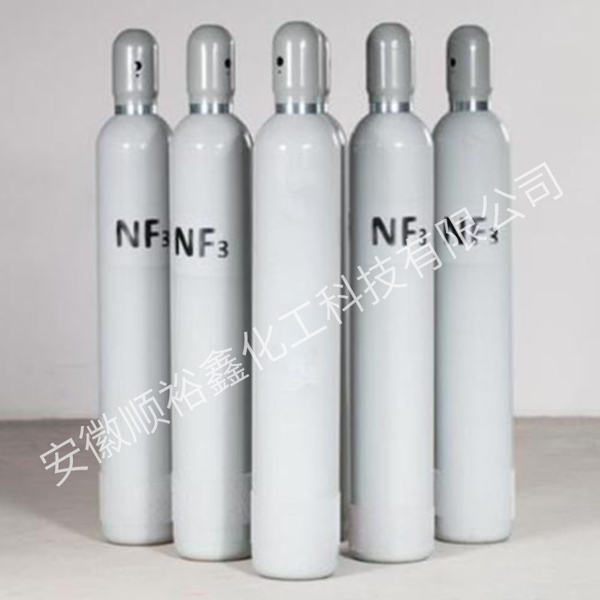Nitrogen trifluoride
2025/8/1
![]()
The technical indicators of electronic grade nitrogen trifluoride (NF₃) need to be strictly classified according to application scenarios (such as semiconductor etching, cleaning, photovoltaics, etc.). The core indicators are as follows:
1. Basic purity level
|
grade |
Purity requirements (volume fraction) |
Applicable scenarios |
|
Basic electronic grade |
≥99.99%(4n) |
Photovoltaic cells, LCD panel manufacturing, etc. |
|
High-purity |
≥99.996% (4n6) |
Semiconductor process above 28nm |
|
Super high-purity |
≥99.999%(5N) |
Advanced process (below 14nm), cold wall CVD chamber cleaning |
|
Cutting-edge |
≥99.9999%(6N) |
3nm/5nm chip manufacturing, photoresist stripping |
Note: About 92.8% of the electronic grade NF₃ in the world are concentrated in the 5N level, and the 6N level has a market share of less than 8% due to process difficulty.
2. Key impurity limit (taking level 5N as an example)
|
Impurity type |
Limit requirements |
The consequences of exceeding the standard |
|
Oxygen + Argon (O₂+Ar) |
≤0.5ppm (5N level requirements ≤1ppm) |
Abnormal oxide film on the wafer surface, threshold voltage drift |
|
Moisture (H₂O) |
≤0.5ppm (dew point ≤-76℃) |
Accelerate cavity corrosion and reduce etch selectivity |
|
Hydrogen fluoride (HF) |
≤0.1ppm |
Corrode the vacuum pump oil, damage the silicon lattice structure |
|
Carbon monoxide (CO) |
≤0.5ppm |
Reduce film deposition uniformity |
|
Total metal ions |
≤1ppb (Na/Fe/K, etc.) |
Induces circuit short circuit and device leakage |
|
Particulate matter (≥0.1μm) |
≤0.1 units/mL |
Causes chip surface defects |
|
Hydrolyzable fluoride |
≤0.03mg/l |
Polluting wafer surface |
Special control items:
Phosphine (PH₃) and hydrogen arsenide (AsH₃) need ≤0.05 ppb (grade 6N)
Greenhouse gas potential (GWP) ≤17,000 (refer to IPCC standard)
3. Packaging and storage and transportation standards
Container requirements
Nickel-based alloy/chromium-molybdenum alloy cylinder, electrolytic polishing and passivation treatment of inner wall.
The valve is made of copper alloy and is equipped with a double blocking and leakage prevention device.
Filling standards
Filling pressure ≤1.5 MPa, three-stage pressure stable filling method is adopted
Filling coefficient ≤0.76 kg/L (trifluoromethane analogy requirements)
Storage and transportation conditions
Store in an environment with a humidity of 45–65% from light.
Pressure fluctuations need to be monitored during the transportation process (bumping frequency ≤2.5 times/second).
Leak alarm threshold is 0.5%, explosion limit is 2.3–82%.
4. Testing methods and standard basis
|
Testing items |
method |
Standard basis |
|
Purity and impurity gas |
Helium ionization gas chromatography (detection limit 10⁻⁶) |
GB/T28726 |
|
moisture |
Optical cavity inactivity spectroscopy (accuracy ±0.01ppm) |
GB/T5832.3 |
|
Metal ions |
ICP-MS (detection limit 0.1ppb) |
SEMI C10/SUT 15587 |
|
Particulate matter |
Laser particle counter (0.1–10μm) |
ISO 21501 |
|
Hydrolyzable fluoride |
Ion chromatography (detection limit 0.03mg/L) |
GB/T 31995 |
Implementation standards:
Purity and safety: GB/T 21287-2021 (replace 2007 version)
Transportation safety: TSG R0006 "Technical Supervision Regulations for Gas Bottle Safety"
5. Application risk correlation
Semiconductor etching:
HF >0.1 ppm will corrode the vacuum system, and O₂ >1 ppm will cause wafer threshold voltage drift.
Cavity cleaning:
Moisture >0.5 ppm reduces the cold wall cleaning efficiency, and metal residue >1 ppb causes device failure.
Photovoltaic manufacturing:
Particulate matter exceeds the standard and causes microcracks on the surface of solar cells, and the photoelectric conversion rate decreases by ≥15%.
A wafer factory suffered a scrapped entire batch of chips due to an oxygen content exceeding the standard (5 ppm), with losses of more than 10 million US dollars.
Anhui Shunyuxin Chemical Technology Co.,Ltd. Copyright disclaimer

